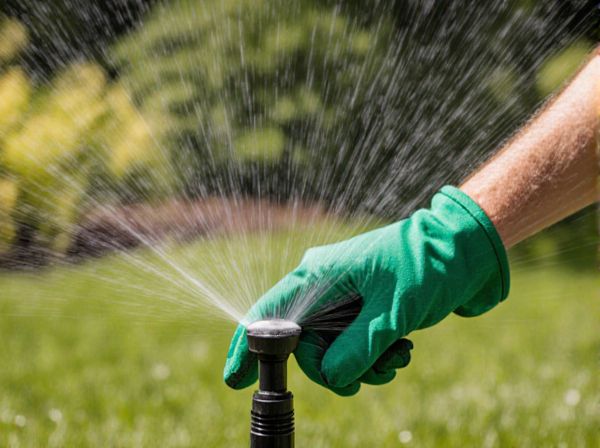
Sprinkler system vs Micro-irrigation system Illustration
A sprinkler system covers large areas by distributing water uniformly over lawns or gardens, making it ideal for expansive landscapes but often leading to higher water loss through evaporation and runoff. Micro-irrigation systems deliver water directly to the plant roots through drip emitters or micro-sprays, maximizing water efficiency and reducing waste. Choosing between the two depends on garden size, plant type, and water conservation goals, with micro-irrigation favored for targeted watering and sustainability.
Table of Comparison
| Feature | Sprinkler System | Micro-Irrigation System |
|---|---|---|
| Water Efficiency | Moderate (50-70%) | High (90%+) |
| Application | Lawn and large areas | Garden beds, shrubs, and trees |
| Water Delivery | Sprays water over a broad area | Delivers water directly to roots via emitters |
| Installation Cost | Moderate | Higher initial cost |
| Maintenance | Low to moderate | Requires regular emitter cleaning |
| Water Pressure Requirement | Higher pressure needed | Operates at low pressure |
| Ideal Use | Open spaces, turfgrass | Precision watering, water conservation |
Introduction to Sprinkler and Micro-Irrigation Systems
Sprinkler systems distribute water through overhead spray, mimicking natural rainfall, and are ideal for covering large areas such as lawns and gardens efficiently. Micro-irrigation systems deliver water directly to the root zones of plants via drip emitters or micro-sprays, minimizing water wastage and enhancing moisture retention. Both systems optimize irrigation but differ significantly in water application methods and suitability for various landscape types.
How Sprinkler Systems Work
Sprinkler systems distribute water through a network of pipes and sprinkler heads that spray water uniformly over a designated area, mimicking natural rainfall. These systems operate under pressure, controlled by timers or sensors to optimize watering schedules and reduce waste. Sprinkler systems are ideal for large lawns and landscapes requiring broad coverage and can be adjusted for different spray patterns and ranges to ensure efficient water distribution.
How Micro-Irrigation Systems Work
Micro-irrigation systems deliver water directly to plant roots through a network of valves, pipes, and emitters, minimizing evaporation and runoff. These systems use low pressure and low flow rates to ensure precise moisture control, enhancing water efficiency and promoting healthier plants. By targeting the root zone, micro-irrigation significantly reduces water waste compared to traditional sprinkler systems.
Water Efficiency Comparison
A micro-irrigation system delivers water directly to the root zone through emitters, reducing evaporation and runoff, which can improve water efficiency by up to 90%. In contrast, sprinkler systems spray water over a wider area, often resulting in higher water loss due to wind drift and evaporation, with water efficiency ranging between 60-75%. Selecting micro-irrigation typically leads to more precise water usage and significant water savings in irrigation practices.
Installation and Maintenance Differences
Sprinkler systems require larger pipe networks and emitters installed above ground, making installation quicker but often more disruptive to landscaping. Micro-irrigation systems involve placing drip lines or emitters directly at the root zone, requiring precise placement and longer installation time to ensure efficient water delivery. Maintenance for sprinkler systems typically involves checking spray patterns and fixing clogged nozzles, while micro-irrigation demands regular inspection for emitter blockages and system flushing to prevent sediment buildup.
Cost Analysis: Sprinkler vs. Micro-Irrigation
Sprinkler systems typically involve higher initial installation costs ranging from $1,500 to $3,000 for residential setups due to extensive piping and equipment requirements, whereas micro-irrigation systems can cost between $500 and $2,000, reflecting their targeted water delivery design that uses less material. Operational expenses for sprinklers also tend to be higher, as they consume more water and energy, potentially increasing monthly utility bills by 20-30%. Micro-irrigation systems optimize water use by delivering moisture directly to plant roots, reducing water waste and lowering irrigation costs by up to 50%, making them more cost-effective over time despite potential maintenance needs for emitters.
Suitability for Different Garden Types
Sprinkler systems are ideal for large, open lawns and gardens with uniform plant spacing, delivering broad water coverage efficiently. Micro-irrigation systems suit gardens with diverse plant types and irregular layouts, providing precise water application directly to the root zones, minimizing waste. Both systems enhance watering efficiency but should be chosen based on garden size, plant variety, and water conservation needs.
Impact on Plant Health
Sprinkler systems deliver water over a broad area, often leading to surface runoff and uneven moisture distribution that can stress plants and promote fungal diseases. Micro-irrigation systems provide precise, targeted watering at the root zone, reducing water waste and minimizing leaf wetness that encourages pathogen growth. This targeted approach enhances plant health by maintaining optimal soil moisture and reducing disease risk.
Environmental Considerations
Sprinkler systems typically consume more water due to evaporation and wind drift, leading to higher water wastage compared to micro-irrigation systems. Micro-irrigation delivers water directly to the plant roots, enhancing water use efficiency and reducing runoff, making it more environmentally sustainable. Choosing micro-irrigation supports conservation efforts by minimizing water consumption and lowering the risk of soil erosion and nutrient leaching.
Choosing the Best System for Your Garden
Choosing the best watering system for your garden depends on factors like plant type, garden size, and water efficiency needs. Sprinkler systems cover large areas quickly and are ideal for lawns, while micro-irrigation systems deliver targeted watering directly to plant roots, reducing water waste and promoting healthy growth. Evaluating your garden's layout and water requirements helps determine the most effective irrigation method to maintain vibrant and sustainable greenery.
Sprinkler system vs Micro-irrigation system Infographic

 gardendif.com
gardendif.com